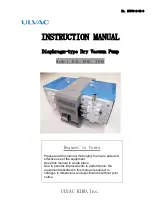
5
3.6 Fitting Piping
The piping (long hose nipple (L-1,L-2)) is not fitted. After opening the packing fit it as
shown in to Fig.3-3.
1) Select Inlet piping(long hose nipple (L-1))attachment point
①
or
②
.
Note: At the time of shipment, a G 1/2 plug is attached to
②
.
2) Attach the G 1/2 plug to the unused hole of
①
or
②
.
3) Put outlet piping(long hose nipple (L-2)) into
③
.
4) Tighten the piping (or G 1/2 plugs) to 1.0+/-0.2 Nm torque. Bed the piping, and G 1/2
plugs on O-rings.
Note: Over-tightening the piping may damage the O-rings.
Fig.3.3 Fitting Piping
3.7 Piping
1) Install piping carefully to prevent leaks.
2) Piping connected to the inlet should be at least 15 mm inside diameter.
3) Ensure that piping connected to the outlet does not cause back pressure. Maximum
back pressure is 0.03 MPa (gauge pressure).
4) In case of selecting the inlet pipe and outlet pipe that are not from our products, please
select the outlet pipe that has same or larger inner diameter length with the inlet pipe.
5) When evacuating a vessel, ensure that a shut-off valve is placed between the pump
inlet pipe and the vessel (see Fig.3.4).
6) When starting the pump, it may not start if the intake-side pressure is lower than the
atmospheric pressure.
Attach an atmospheric release leak valve between the pump inlet pipe and vessel, and
set the intake-side pressure to atmospheric pressure when starting the pump.
After starting the pump, always close the leak valve.
Fig.3.4 Example of Piping Used When Evacuating a Vessel
3.8 Storage
Turn the switch OFF (set to O), remove the power plug from the outlet, place the rubber
caps over the inlet and outlet, and store the pump in an area of low humidity.
Vacuum pump
Filter
Leak valve
Shut-off valve Vessel
Outlet piping
(long hose nipple
(L-2))
G 1/2 plug
1
2
Inlet piping (long hose
nipple (L-1))
3
















































